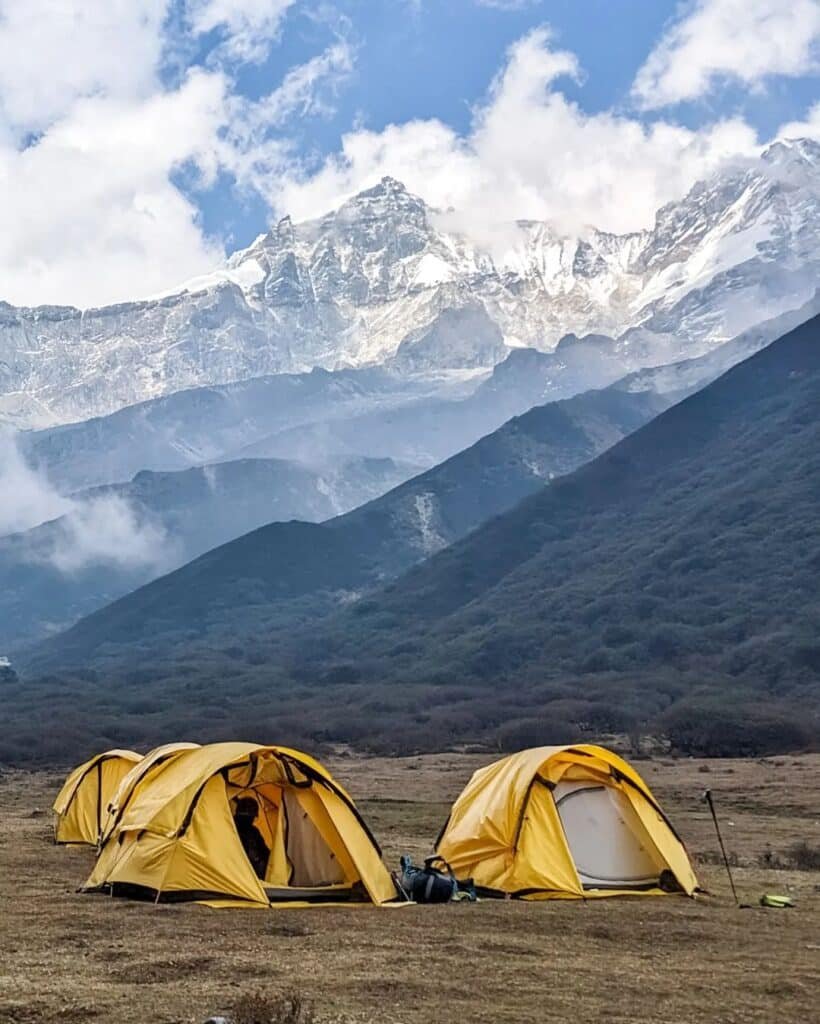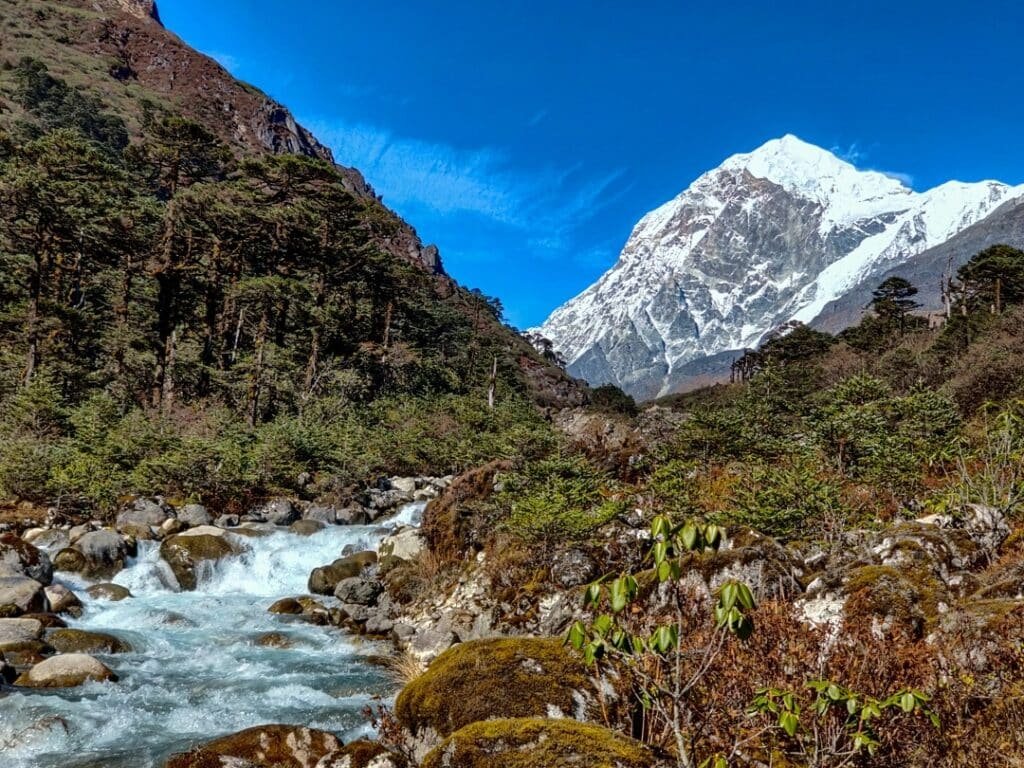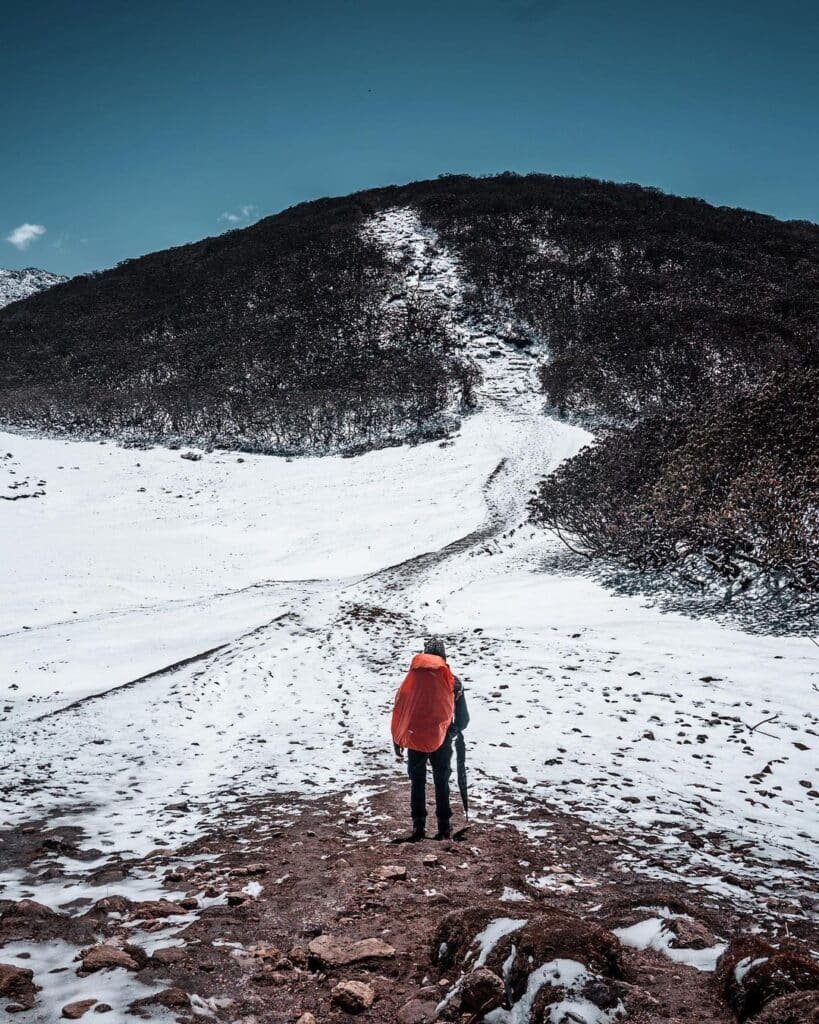Goechala Trek: The Ultimate Trek Guide for Adventure
- Trekking Destinations
-
Jul 04
- Share post
Embark on an exhilarating journey into the heart of the Himalayas with this comprehensive guide to the Goechala Trek. Tucked away in the ethereal landscapes of Sikkim, Goechala is a paradise for adventure enthusiasts and nature lovers alike.
This guide is designed to walk you through every aspect of this trek: from a detailed day-to-day itinerary to insightful tips about the best seasons, fitness requirements, budgeting, and how to reach the starting point. We’ll even highlight the unique landmarks and experiences that make this trek memorable.
Whether you’re a seasoned trekker or a first-timer, our guide promises to equip you with the knowledge and confidence to conquer the Goechala Trek. So, tie your laces, pack your bags, and let’s set off on this Himalayan adventure!
- Max Altitude: 15,100 Ft. (5,227M)
- Average Trekking Fees: ₹15,000 – ₹18,000
- Distance: 75 – 90 kms
- Difficulty: Difficult
- Duration: 10-11 days
- Ideal For: Experienced Trekkers Only
- Best Season: February - June & September - November
- Region: Sikkim
Table of Contents
ToggleGoechala Trek: An Overview

The Goechala Trek is through the Kanchenjunga National Park situated in the northeastern Indian state of Sikkim. The trek provides an up-close view of the Kanchenjunga, the third-highest mountain in the world. The starting point of the trek is Yuksom, a small town in West Sikkim.
This trek covers about 77-90 kilometres. It showcases diverse landscapes such as oak, rhododendrons, pine forests, alpine meadows with vibrant wildflowers, and a dramatic panorama of the Himalayan range.
This trek spans 8-11 days, with the highest point being the Goechala View point I at 15,100 feet. The pass provides an astounding view of the Kanchenjunga, Mount Pandim and other majestic peaks. The trail offers chances to encounter unique Himalayan wildlife and exposes trekkers to the rich culture of Sikkim with its traditional Buddhist monasteries and prayer flags.
The Goecha la trek is rated moderate to difficult, requiring a good level of physical fitness. The best time to undertake the walk is during spring (April to June) and post-monsoon (September to November). The trek is a beautiful opportunity to experience nature’s grandeur, with the area still relatively untouched by mass tourism.
Goechala Trek Difficulty & Duration

The Goechala Trek, with a difficulty level rated as difficult, is certainly not for the faint-hearted. The trek spans about 90 kilometres, typically covered throughout 8-11 days.
Each day, trekkers are expected to hike 10-12 kilometres which can take approximately 5-7 hours, depending on the terrain and individual pace. The demanding nature of the landscape, combined with the high altitude of the trek, makes it quite challenging, even for seasoned trekkers.
Regarding the physical fitness requirement, participants must be in excellent physical condition. This trek requires stamina and endurance, and it is advised to start a fitness regimen at least 2-3 months before the trek. Activities such as cardio exercises, strength training, and flexibility exercises should be included in the fitness regimen.
Another important aspect is getting acclimated to the high altitudes. With the highest point at 15,100 feet, trekkers may experience symptoms of altitude sickness. Therefore, taking necessary precautions and following a gradual ascent is crucial to adapt to the thinning oxygen levels.
With these rigorous requirements, the Goechala Trek offers an immersive and rewarding experience to those ready to take on its challenge.
Best Season for the Goechala Trek

The Goechala Trek can be best enjoyed in two seasons: Summer (March to June) and Autumn (September to November).
Summer (March to June) is a great time to trek Goechala. The weather is terrific, with average temperatures between 10°C to 20°C. It’s not too cold, which makes the trek easier. In Summer, the paths are filled with blooming rhododendron flowers, which make the journey very colourful. This time is also suitable for bird watching. But there is one small problem. Summer can sometimes bring rain. So, it might get a bit slippery on the trails. Also, you might have to carry rain gear, which can make your bags heavier.
In Autumn (September to November), the sky is more evident. Enjoying the majestic view of Kanchenjunga and other high peaks is a great time. The average temperatures during this season range from 0°C to 15°C. The weather can get quite cold, especially in the morning and at night. It’s essential to carry warm clothes. The trails are less slippery in Autumn, which makes the trek safer. But, there are fewer flowers and birds to see during this season.
In summary, both seasons have their own beauty. Summer offers a more vibrant and lively experience, while Autumn provides clearer and safer trekking conditions. Both seasons offer a fantastic view of Kanchenjunga, making the Goechala Trek a grand adventure any time you choose to go.
Costing & Budgeting

If you’re planning to undertake the adventurous Goechala Trek, it’s essential to consider the following costs.
- Firstly, the Average Trekking Fees for the Goechala Trek range between ₹15,000 – ₹18,000. This is typically charged by the trekking organisations in India and usually includes accommodations and meals for the duration of the trek.
- Transportation to the starting point, Yuksom, is another crucial factor. Depending on your location, you may need to take a flight, a train or a bus to reach Sikkim. Flight prices differ greatly depending on the season and how far in advance you book, while train and bus prices tend to be more consistent. Therefore, planning and booking your tickets is advisable to secure the best rates.
- Although accommodation is usually included in the trekking fees, it’s essential to budget any pre or post-trek accommodation you may need in Yuksom or other parts of Sikkim.
- For the trek, you will need special Equipment & Gear. This includes sturdy trekking shoes, thermal wear, a good rucksack, and other essentials. To save costs, consider renting gear instead of buying. Many cities have shops that rent out high-quality trekking equipment.
- While Food & Water is typically included in the trekking fees, carrying extra snacks is wise. Energy bars, dried fruits, and nuts are light to carry and provide quick energy during the trek.
- Lastly, always plan for Miscellaneous Expenses. These can include personal medicines, fees for a trekking guide if not included in your package, and souvenirs.
Planning your budget well in advance will ensure you have a stress-free and enjoyable trekking experience.
How To Reach?

The Goechala Trek’s starting point, Yuksom, can be reached via flights, trains, or buses.
- By Air: The closest airport to Yuksom is Bagdogra Airport in Siliguri, West Bengal. It is well-connected with major Indian cities like Delhi, Kolkata, Mumbai, and Bangalore. Upon landing, you can take a taxi or shared cab to reach Yuksom, which is approximately a 5-6 hour drive. While this is the quickest method, it can be more expensive than other options.
- By Train: New Jalpaiguri Railway Station (NJP) in Siliguri is the nearest railway station to Yuksom. Trains to NJP are available from many major cities across India. From NJP, one can hire a taxi or shared cab to reach Yuksom, a journey of about 5-6 hours. This is generally a cheaper option than flying, and it offers a chance to enjoy the scenic landscapes of North-East India.
- By Bus: You can also reach Yuksom by bus from Siliguri, though it is less convenient as there’s no direct bus service. You can take a bus to Jorethang or Geyzing and hire a taxi to reach Yuksom. The entire journey can take around 7-8 hours.
Most trekking organisations arrange for a pickup and drop from Siliguri. However, be sure to confirm this when booking.
While flights offer the quickest way to reach the starting point, trains provide the cheapest option. Regardless of your chosen method, account for the 5-6 hours of travel time to reach Yuksom from Siliguri.
Detailed Itinerary for the Goechala Trek

Section I
Day 1: Arrival at Yuksom (5,577 ft). Arrive at Yuksom, the first capital of Sikkim and the starting point of the trek. It’s a quaint town rich in Sikkimese history. Spend the day exploring local attractions, like the Norbugang Coronation Throne and Dubdi Monastery.
2nd Day: Yuksom to Sachen (7,150 ft)
- Distance: 8 km
- Time: 5-6 hours.
- Start your trek through the beautiful landscape towards Sachen. As you traverse dense, moss-laden forests, cross the Pha Khola and the Tshushay Khola, two charming bridges over pristine mountain streams, before reaching the Sachen camp site.
Day 3: Sachen to Tshoka (9,650 ft)
- Distance: 7 km
- Time: 4-5 hours
- Begin the day with a hike towards the Prek Chu River, followed by a steep climb towards Bakhim.
4th Day: Tshoka to Dzongri Top (12,980 ft)
- Distance: 9 km
- Time: 5-6 hours
- Today you trek to Dzongri, the trail takes you through dense forests and alpine meadows, blooming with rhododendrons. As you ascend towards Phedang, you get your first glimpse of the mighty Kanchenjunga range. Continue hiking to reach Dzongri, your camp for the night.
Day 5: Rest day at Dzongri. Take a day off to acclimatise. You can explore nearby ridges or relax at the campsite, enjoying stunning panoramic views of the surrounding snow-clad peaks.
Section II
6th Day: Dzongri to Thansing (12,900 ft)
- Distance: 8 km
- Time: 4-5 hours
- Start your day with a gradual ascent to a ridge, offering panoramic views of Kanchenjunga and Pandim peaks. Follow the trail that descends through meadows and rhododendron forests to reach the campsite at Thansing.
Day 7: Thansing to Lamuney (13,700 ft)
- Distance: 4 km
- Time: 2-3 hours.
- This short trekking day takes you through grassy meadows alongside the Prek Chu River to Lamuney. The campsite offers breathtaking views of the majestic Pandim and other Himalayan peaks.
Day 8: Lamuney to Goechala Viewpoint (15,100 ft) via Samiti Lake and back to Thansing
- Distance: 10 km
- Time: 7-8 hours.
- Starting before dawn, trek towards the mystical Samiti Lake. Its serene, emerald-blue waters against the backdrop of highest mountains create a surreal atmosphere. From the lake, continue the ascent to reach the Goechala viewpoint. Witness the breathtaking sunrise over the Kanchenjunga, then begin your descent back to Thansing.
9th Day: Thansing to Tshoka
- Distance: 16 km
- Time: 6-7 hours.
- Retrace your steps, descending through rhododendron forests and alpine meadows. The descent is easier and faster, allowing you to reach Tshoka well before evening.
Day 10: Tshoka to Yuksom
- Distance: 15 km
- Time: 6-7 hours.
- The final day of trekking brings you back to Yuksom. This trail will seem familiar, but the views are just as stunning in reverse. Celebrate the completion of the trek and rest for the night.
Day 11: Departure from Yuksom. After breakfast, say goodbye to the mountains and begin your journey home, carrying memories of a lifetime.
Highlights of the Goechala Trek

The Goechala Trek is an enchanting journey in the lap of the Himalayas, presenting an array of awe-inspiring experiences and visuals. Here are some highlights of this adventure:
- Kanchenjunga Close-up: The major attraction of the Goechala Trek is the breathtaking view of Mount Kanchenjunga, the third-highest peak in the world, from the trek’s viewpoint. You get a stunning, up-close view of this majestic mountain and other grand peaks of the Himalayan range.
- Lush Forests: The trek takes you through dense, verdant forests of rhododendrons, oaks, and pines. Walking through these forests feels like stepping into a fairy tale, especially during the spring when the rhododendrons bloom, painting the trail in various shades of red and pink.
- Vibrant Flora and Fauna: The trail offers a chance to spot unique Himalayan wildlife, such as the Himalayan Black Bear and various exotic birds. You’ll also encounter a myriad of colourful wildflowers and medicinal plants.
- Alpine Meadows: As you ascend, the dense forests give way to vast, beautiful alpine meadows known as ‘Bugyals’. These expansive grasslands, set against the backdrop of snow-clad mountains, are a sight to behold.
- Cultural Exposure: Get a glimpse into the rich culture of Sikkim, with its traditional Buddhist monasteries and fluttering prayer flags along the trails.
- Rivers and Lakes: Along the route, you cross the crystal clear Rathong River and witness the serene beauty of Samiti Lake, nestled amidst the mountains.
- Goechala Viewpoint: The sunrise from this point, casting golden hues on the Kanchenjunga, is unforgettable.
Each day on the Goechala Trek unveils a new aspect of the region’s beauty, making it a truly captivating experience for every adventurer.
Safety Tips & Precautions
Safety should always be a top priority. Here are some essential safety tips to keep in mind during the Goechala Trek:
- Go with an experienced guide and follow their instructions.
- Stay hydrated and carry an adequate supply of water.
- Pack light and carry only the essential items.
- Dress in layers to adapt to changing weather conditions.
- Respect the environment and maintain cleanliness.
- Inform someone about your trekking plans and expected return.
- Stay updated about weather conditions and local regulations.
- Avoid alcohol and smoking.
Essential Gear and Equipment for Goechala Trek
Before embarking, it is essential to pack the right gear and equipment to ensure a safe and comfortable journey. Here is a list of items you should consider carrying:
- Trekking shoes with good ankle support
- Backpack with rain cover
- Trekking gaiters
- Warm and waterproof clothing layers
- Sleeping bag suitable for sub-zero temperatures
- Trekking poles for better stability on uneven terrains
- UV-protected sunglasses and sunscreen
- Water bottles and water purification tablets
- Headlamp or flashlight with extra batteries
- First aid kit with essential medications
- Portable power bank for charging electronic devices
- Foreign trekkers need an inner line permit
In conclusion, the Goechala Trek is more than just a physical challenge; it’s a journey of self-discovery set against the awe-inspiring backdrop of the mighty Himalayas.
As you navigate through dense forests, serene lakes, vibrant meadows, and snow-laden paths, you’ll experience a profound connection with nature that is both humbling and uplifting.
Whether it’s the first rays of the sun hitting the majestic Kanchenjunga or the simple joy of camping under the starlit sky, the memories will remain etched in your heart for a lifetime.
We hope this comprehensive guide equips you with all the necessary information to successfully undertake this trek. So, embrace the adventure and let the magic of the Himalayas inspire and transform you. Happy trekking!
Comments
Add a comment
Leave a Reply · Cancel reply
This site uses Akismet to reduce spam. Learn how your comment data is processed.
